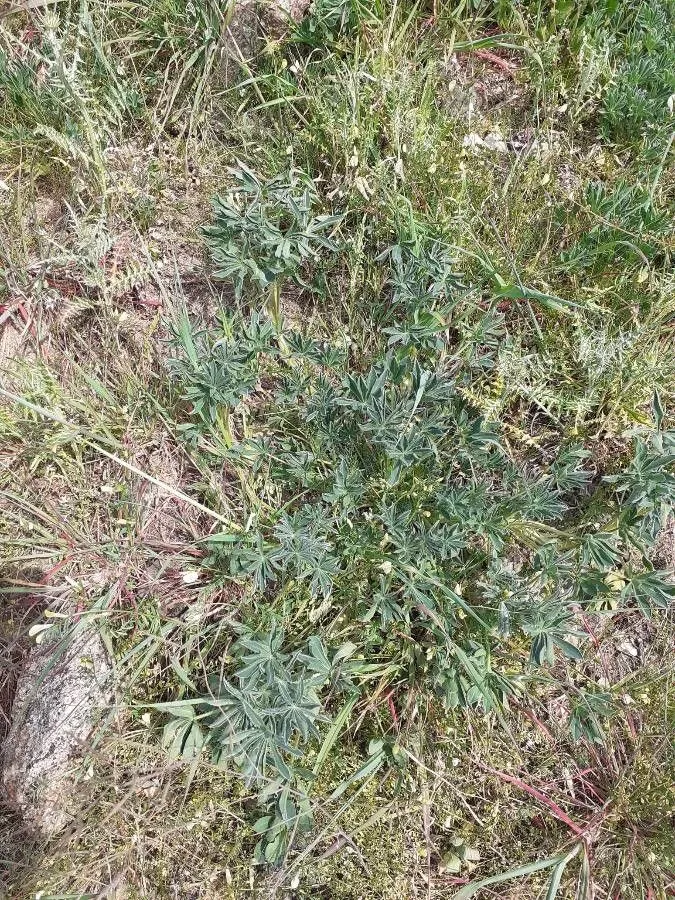
Author: L.
Bibliography: Sp. Pl.: 722 (1753)
Year: 1753
Status: accepted
Rank: species
Genus: Lupinus
Vegetable: False
Observations: W. & C. Medit.
The Annual Yellow Lupin, a remarkable and vibrant addition to both wild and cultivated landscapes, is botanically recognized as Lupinus luteus. This species, first described in 1753 in Species Plantarum by the renowned botanist Carl Linnaeus, is cherished for its stunning yellow flowers and its role within ecosystems.
Belonging to the Fabaceae family, which is notable for its diverse and ecologically significant legumes, the Annual Yellow Lupin exemplifies the symbiotic relationships characteristic of this family. These plants often thrive in Mediterranean-like climates, flourishing in regions with mild, wet winters and hot, dry summers. The specific attribution “W. & C. Medit.” indicates that this species is typical to Western and Central Mediterranean regions.
The Annual Yellow Lupin is particularly valued for its adaptability and the benefits it brings to agricultural practices. It enhances soil fertility through nitrogen fixation, a process where symbiotic bacteria in the plant’s root nodules convert atmospheric nitrogen into a form that plants can utilize. This natural fertilization process reduces the need for chemical fertilizers, promoting sustainable farming practices.
Visually, Lupinus luteus is a spectacle of nature’s artistry. The striking yellow blooms not only add aesthetic delight to gardens and fields but also play a crucial role in supporting pollinators such as bees and butterflies. These insects, drawn to the vivid flowers, assist in cross-pollination, thereby maintaining the biodiversity and resilience of ecosystems.
In summary, the Annual Yellow Lupin, or Lupinus luteus, is a plant of significant botanical interest and environmental importance. Its history traces back to the meticulous records of Linnaeus in 1753, and it continues to thrive in its native Mediterranean habitats. As a member of the Fabaceae family, it contributes both beauty and ecological benefits, exemplifying the interconnectedness of life and the profound impact of plant species on their surroundings.
Dan: alaska-lupin, gul lupin
Eng: european yellow lupine, annual yellow lupin, yellow lupine, annual yellow-lupin, yellow lupin
Deu: gelbe lupine, hasenklee
Fra: lupin jaune
Spa: altramuz amarillo, tremoceiro-amarelo
Lav: dzelten
Swe: gul-lupin, gullupin, gul lupin
Ces: lupina žlutá, lupína žltá
Ita: lupino giallo
Por: lupino-amarelo, tremoçeiro-amarelo, tremoço, tremoço-amarelo, tremoço-de-cheiro
Hun: sárga csillagfürt
Nld: gele lupine
En: Annual yellow lupin, Yellow lupine, European yellow lupine, Yellow Lupin, Annual Yellow-lupin, Lupino Amarillo
Ar: ترمس أصفر
Eu: Eskuhori
Be: Лубін жоўты
Bg: Жълта лупина
Ca: Llobí groc
Zh: 黄羽扇豆
Cs: Lupina žlutá, Lupína žltá
Da: Alaska-lupin, Gul lupin
Nl: Gele lupine
Et: Kollane lupiin
Fi: Keltalupiini
Fr: Lupin jaune, Lupin jaune soufre
De: Hasenklee, Gelbe Lupine
He: תורמוס צהוב
Hu: Sárga csillagfürt
Is: Ilmlúpína
It: Lupino giallo, Lupinus luteus, Lupinetto Giallo
Lv: Dzeltenā lupīna, Dzelten
Pl: Łubin żółty
Pt: Tremoçeiro-amarelo, Tremoço-amarelo, Lupino-amarelo, Tremoço, Tremoço-de-cheiro, Tremoceiro
Ru: Люпин жёлтый
Es: Altramuz amarillo, Lupino Amarillo, Tremoceiro-amarelo
Sv: Gul-lupin, Gullupin, Gul lupin
Tr: Sarı acı bakla
Uk: Люпин жовтий
Taken May 17, 2021 by Sergio costantini (cc-by-sa)
Taken May 14, 2021 by Verónica Rodríguez Vicente (cc-by-sa)
Taken Apr 5, 2021 by Franco-Parguiña Héctor (cc-by-sa)
Taken Apr 27, 2019 by Chiño Alvarez (cc-by-sa)
Taken Mar 11, 2017 by Robert Hofman (cc-by-sa)
Taken Apr 26, 2016 by Tela Botanica − Liliane ROUBAUDI (cc-by-sa)
Taken Apr 26, 2016 by Tela Botanica − Liliane ROUBAUDI (cc-by-sa)
Taken Apr 25, 2016 by Tela Botanica − Genevieve BOTTI (cc-by-sa)
Taken Mar 20, 2021 by Prieta Javier (cc-by-sa)
Taken May 17, 2021 by Sergio costantini (cc-by-sa)
Taken Mar 20, 2021 by Prieta Javier (cc-by-sa)
Taken Apr 11, 2022 by Makario (cc-by-sa)
Taken Mar 20, 2021 by Prieta Javier (cc-by-sa)
Taken Apr 12, 2022 by Manuel Barón (cc-by-sa)
Taken Apr 27, 2019 by Chiño Alvarez (cc-by-sa)
Taken Apr 15, 2009 by Photoflora – Benoit BOCK (©)
Taken Jan 1, 1970 by Photoflora – L’Abbé COSTE (©)
Taken Apr 8, 2000 by Tela Botanica − Liliane Roubaudi (cc-by-sa)
Taken Apr 8, 2000 by Tela Botanica − Liliane Roubaudi (cc-by-sa)
Taken Apr 8, 2000 by Tela Botanica − Liliane Roubaudi (cc-by-sa)
Taken May 15, 2015 by Photoflora – Jean-Luc TASSET (©)
Taken Mar 23, 2020 by Sara Ko (cc-by-sa)
Taken Apr 29, 2019 by Buzzo G (cc-by-sa)
Taken Mar 27, 2020 by Pereira Jorge (cc-by-sa)
Taken Apr 6, 2021 by Tânia Ferreira (cc-by-sa)
Taken Oct 9, 2022 by Adventure Wynn (cc-by-sa)
© copyright of the Board of Trustees of the Royal Botanic Gardens, Kew.
© copyright of the Board of Trustees of the Royal Botanic Gardens, Kew.
© copyright of the Board of Trustees of the Royal Botanic Gardens, Kew.
Growth form: Single Crown
Growth habit: Forb/herb
Growth rate: Rapid
Ph maximum: 7.0
Ph minimum: 5.6
Light: 7
Atmospheric humidity: 5
Soil nutriments: 7
Family: Myrtaceae Author: (F.Muell.) K.D.Hill & L.A.S.Johnson Bibliography: Telopea 6: 402 (1995) Year: 1995 Status:…
Family: Rubiaceae Author: Pierre ex A.Froehner Bibliography: Notizbl. Bot. Gart. Berlin-Dahlem 1: 237 (1897) Year:…
Family: Sapindaceae Author: Koidz. Bibliography: J. Coll. Sci. Imp. Univ. Tokyo 32(1): 38 (1911) Year:…
Family: Asteraceae Author: A.Gray Bibliography: Pacif. Railr. Rep.: 107 (1857) Year: 1857 Status: accepted Rank:…
Family: Fabaceae Author: Medik. Bibliography: Vorles. Churpfälz. Phys.-Ökon. Ges. 2: 398 (1787) Year: 1787 Status:…
Family: Aspleniaceae Author: (Cav.) Alston Bibliography: Bull. Misc. Inform. Kew 1932: 309 (1932) Year: 1932…